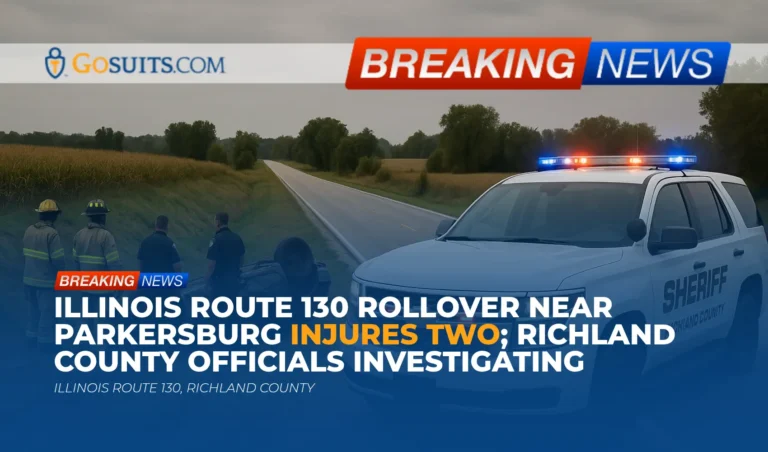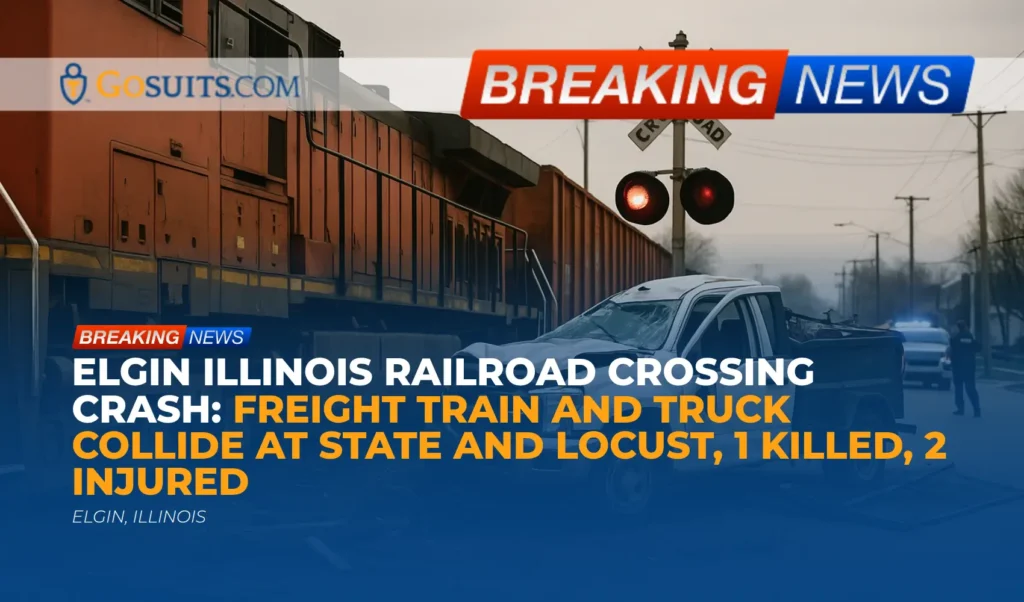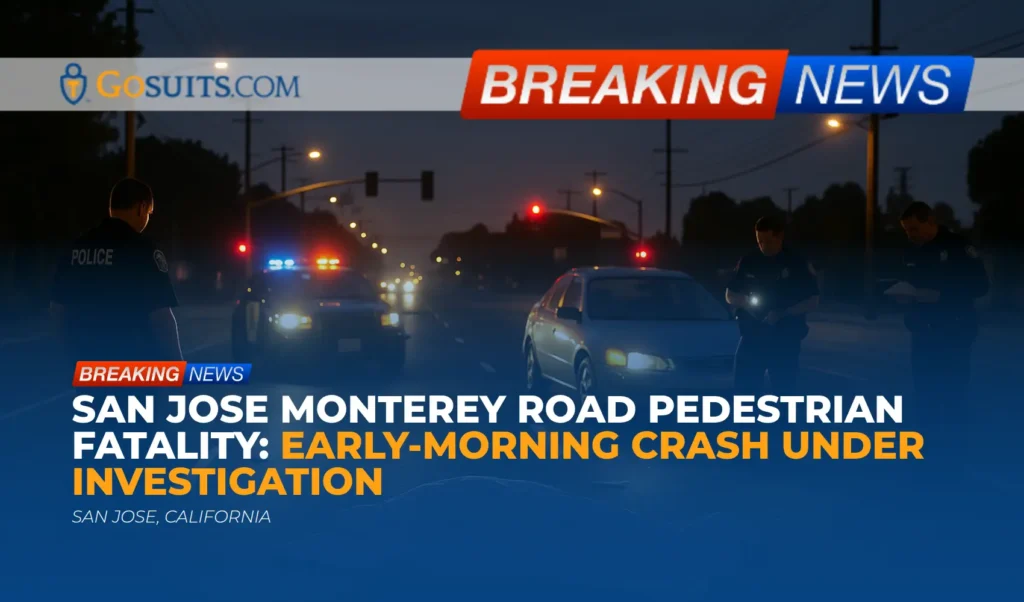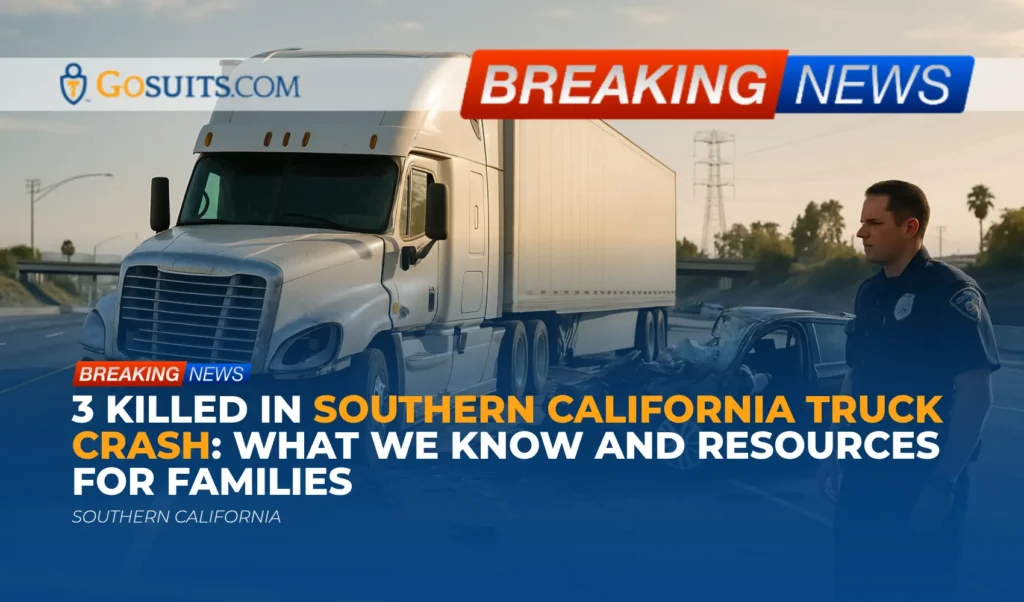- What happened on Illinois Route 130 in Richland County
- Status of the investigation and what it typically involves
- Injuries, emergency response, and early health steps
- Legal context in Illinois: liability, shared fault, and key deadlines
- Insurance considerations after a single-vehicle rollover
- Preserving evidence after a roadway crash
- Getting official records and information
- Safety notes about rollovers and roadway departures
- How community members can support those affected
- Commentary from Gosuits Parkersburg, Illinois Personal Injury Attorney
- Time-sensitive next steps
What happened on Illinois Route 130 in Richland County
Authorities are investigating a single-vehicle crash that occurred late Monday morning, October 13, along Illinois Route 130 in Richland County. Officials reported that a northbound vehicle left the roadway a little over a mile northwest of Parkersburg, near North Woods Lane. The vehicle struck a ditch embankment and rolled over.
The driver, a 60-year-old resident of West Salem, and a passenger, age 61 and also from West Salem, were both airlifted to a nearby hospital with injuries described as non-life-threatening. The Richland County Sheriff’s Department responded and coordinated with other emergency personnel at the scene. Investigators have not yet released the cause of the crash.
In single-vehicle rollovers, investigators typically evaluate roadway conditions, vehicle issues, driver inputs, and any environmental factors to understand what led to the departure from the roadway. Even when only one vehicle is involved, there can be multiple contributing factors, some of which may be outside the driver’s control.
Status of the investigation and what it typically involves
At this stage, law enforcement has indicated the cause remains under investigation. While each investigation is unique, collision investigators commonly take several steps to reconstruct what happened and why. These can include:
- Scene documentation: Measuring tire marks, gouges, vehicle rest position, and damage patterns; photographing the roadway, signage, embankments, and surroundings.
- Roadway condition checks: Looking for loose gravel, shoulder drop-offs, debris, faded or missing edge lines, insufficient signage, or uneven surfaces that could contribute to roadway departures.
- Vehicle examination: Inspecting tires for blowouts or tread separation, brakes, steering components, and potential mechanical failures. Some vehicles store crash-related data.
- Event data recorder (EDR): Depending on the vehicle, an EDR may capture speed, brake application, steering input, and seatbelt status near the time of the crash. Access often requires specialized tools. For context on EDRs, the National Highway Traffic Safety Administration provides information at NHTSA EDR overview.
- Witness interviews: Speaking with any bystanders, nearby residents, or first responders who can describe vehicle behavior or roadway conditions before the crash.
- Weather and lighting: Reviewing conditions that may have affected traction or visibility.
These steps help determine whether driver error, vehicle issues, or external hazards (such as roadway design or maintenance problems) played roles. While officials will ultimately issue their findings, those affected may also benefit from an independent review that looks at the same factors through a civil-injury lens.
Injuries, emergency response, and early health steps
Both occupants were airlifted to a hospital with non-life-threatening injuries. Air medical transport is commonly used when injuries may be serious or when specialized trauma care is needed quickly. Even when injuries are described as non-life-threatening, internal or delayed-onset symptoms can emerge in the hours and days after a rollover. It’s vital for anyone involved in a crash to follow discharge instructions, attend follow-up appointments, and seek immediate medical attention if new or worsening symptoms appear.
Common injuries in rollovers can include concussions or other traumatic brain injuries, neck and back strain, fractures, soft tissue injuries, and psychological trauma. Early documentation of symptoms, keeping copies of imaging studies, and adhering to medical advice helps both with recovery and with any later insurance evaluations.
Relatives and friends can support recovery by arranging transportation to appointments, coordinating medications, tracking symptoms in a journal or phone notes, and helping organize medical bills and records.
Legal context in Illinois: liability, shared fault, and key deadlines
When a collision involves a single vehicle, it is natural to assume the driver is solely responsible. However, law in Illinois allows injury claims to consider a broader range of contributing causes, including vehicle defects, negligent maintenance by a service provider, or unsafe roadway conditions (for example, inadequate shoulders, missing edge lines, or unaddressed hazards).
Comparative fault
Illinois follows a modified comparative negligence standard. An injured person can pursue compensation provided they are not more than 50 percent at fault. If a claimant shares some responsibility, any award can be reduced by their percentage of fault. The statute is codified at 735 ILCS 5/2-1116.
Statute of limitations
Most Illinois personal injury claims must be filed within two years of the injury. Missing this deadline can bar a claim, with limited exceptions. The general two-year limitation period appears at 735 ILCS 5/13-202. Different timelines can apply in cases involving governmental entities or for certain claim types, so it is important to confirm the correct date for the specific circumstances.
Claims potentially implicated in a roadway departure or rollover
- Negligence claims: Against a driver, service provider, or other party whose actions contributed to the crash.
- Product liability: If a defective tire, steering component, airbag, or other vehicle system played a role.
- Premises or roadway maintenance theories: If evidence shows hazardous roadway conditions, inadequate warnings, or failure to maintain safe shoulders and clear zones.
Determining what claims are viable depends on evidence. Early investigation, vehicle preservation, and thorough documentation are key.
Insurance considerations after a single-vehicle rollover
Navigating insurance after a serious crash can feel overwhelming. Illinois requires drivers to carry minimum liability insurance, and most policies also include coverages like medical payments, collision, and uninsured/underinsured motorist protection. The Illinois Secretary of State provides an overview of mandatory insurance at ilsos.gov.
Before contacting any insurance company
It is generally wise to consult with a seasoned personal injury attorney first. Statements made to any insurer, including your own, can be recorded and later used to dispute the extent of injuries or fault. A consultation helps clarify rights, obligations, and the best sequence for notifying carriers.
Potential coverages to review
- Medical payments (MedPay): Can help cover immediate medical expenses regardless of fault, up to policy limits.
- Collision coverage: Addresses vehicle repair or total loss, subject to deductibles.
- Uninsured/underinsured motorist (UM/UIM): In some single-vehicle scenarios, another party may have contributed indirectly (e.g., a road hazard created by a third party). UM/UIM can be relevant if another liable party lacks adequate coverage.
- Liability coverage: Applies if claims are made against the driver by an injured passenger.
Insurers may request medical authorizations broader than necessary or push for quick settlements before the full scope of injuries is known. Carefully limiting authorizations to relevant dates and providers, tracking all medical expenses, and waiting for a clear diagnosis can prevent avoidable disputes.
Preserving evidence after a roadway crash
Key evidence can be lost or altered within days or weeks of a crash. Timely steps make a difference:
- Secure the vehicle: Avoid repairing or discarding the vehicle until it can be inspected and photographed. Ask the tow yard or storage facility to retain it and document chain-of-custody.
- Request an EDR download: If the vehicle has an event data recorder, send a written preservation request to the current custodian. EDR data can be overwritten if the battery is disconnected or the vehicle is moved extensively. See the NHTSA resource on event data recorders for general information.
- Photograph the scene: Capture roadway edges, shoulders, embankments, signage, and any visible hazards or debris. Revisit at the same time of day to replicate lighting, if feasible and safe.
- Identify witnesses: Collect names and contact information for anyone who saw the vehicle before the departure or arrived immediately after.
- Keep all medical records: Discharge summaries, imaging, prescriptions, and therapy notes help establish injury scope and timeline.
- Document expenses and impacts: Maintain a log of missed work, out-of-pocket costs, caregiver time, and daily activity changes due to injuries.

Getting official records and information
Obtaining official records provides clarity and supports any necessary claims. Below are common sources and how they are typically accessed in Illinois. Availability and process can vary by agency.
Police crash report
- Responding agency: The Richland County Sheriff’s Department responded. Their office is generally the first point of contact to request the crash report number and instructions for obtaining a copy. Many Illinois sheriff’s offices release reports after the investigation is sufficiently documented.
- Illinois State Police crash reports portal: Some Illinois crash reports are accessible through the Illinois State Police. See Illinois State Police Crash Reports for guidance and availability by agency.
- IDOT crash data: For statewide trends and historical context, the Illinois Department of Transportation publishes crash data and summaries at IDOT Crash Data. This is not a substitute for the specific police report, but it can help understand broader safety patterns.
Medical records and transport documents
- Hospital records: Patients can request their own medical records, including imaging and lab results, under federal HIPAA rules. The U.S. Department of Health and Human Services explains these rights at HHS Medical Records Access.
- Air medical transport records: Air ambulance providers keep dispatch notes and medical documentation. Patients may request copies; providers usually require a HIPAA-compliant authorization.
- Primary care and follow-up: Keep all visit summaries and referrals. Ask providers for written work restrictions and therapy plans.
Coroner and autopsy information
This crash was reported as non-fatal. In general, if a roadway incident involves a fatality in Illinois, the county coroner conducts or oversees the investigation and determines cause and manner of death. Next of kin can typically request the coroner’s report and, when performed, the autopsy report, subject to legal requirements. Procedures vary by county, and some records are restricted during open investigations.
Freedom of Information Act (FOIA) requests
If an agency does not release certain records informally, the Illinois Freedom of Information Act provides a route to request public records. Guidance is available through the Illinois Attorney General at Illinois FOIA. FOIA does not guarantee access to records that are exempt, such as some investigatory materials during an active investigation, but it can be an effective tool once the case is closed or in part during the process.
Safety notes about rollovers and roadway departures
Rollover crashes are relatively uncommon compared to other crash types, but they disproportionately account for serious injuries. Leaving the roadway and encountering steep slopes, soft shoulders, or embankments can increase the likelihood of a rollover.
Federal safety agencies provide context on rollover dynamics and prevention. The National Highway Traffic Safety Administration offers an overview at NHTSA Rollover Safety. For roadway engineering strategies that reduce roadway departure crashes, see the Federal Highway Administration’s resources at FHWA Roadway Departure Safety. These resources explain measures such as maintaining clear zones, improving edge lines and rumble strips, and designing safer slopes near the roadway.
While the cause of this specific crash remains under investigation, public information about rollovers underscores the importance of seat belt use, proper tire maintenance, and cautious driving on rural highways where shoulders, ditches, and embankments can vary.
How community members can support those affected
Recovering after a serious crash can be physically and emotionally demanding. Community support matters. Friends, neighbors, and colleagues can make a meaningful difference by offering practical help and respectful encouragement.
- Offer transportation and errands: Help with medical appointments, groceries, and pharmacy pickups.
- Meal coordination: Organize a schedule so the household has steady support without feeling overwhelmed.
- Respect privacy and preferences: Ask before sharing updates publicly. Keep sensitive health details confidential.
- Check in on mental health: Crashes can bring anxiety, sleep changes, or trauma responses. Gentle check-ins and patience matter.
- Assist with paperwork: Help organize bills, claim letters, and appointment reminders.
Commentary from Gosuits Parkersburg, Illinois Personal Injury Attorney
Our hearts go out to those injured in this rollover on Illinois Route 130, and to their families and friends who are now focused on healing. This overview is intended for general information, to help the community understand the kinds of questions that arise after a serious crash and where important records may be found.
Based on the information reported, investigators are still determining why the vehicle left the roadway and rolled near an embankment. In our experience with rural highway incidents, careful attention to roadway conditions, shoulder stability, signage, and vehicle integrity can be just as important as driver inputs. A thorough, methodical review can reveal whether multiple factors combined to produce a dangerous situation.
Insurance carriers and large corporations often move quickly after an incident. Adjusters may request broad medical authorizations, seek recorded statements, or propose early settlements before the full scope of injuries is understood. These tactics can take advantage of a person’s lack of familiarity with the process and the understandable urge to put the event behind them. Taking time to understand rights, preserving evidence, and getting a free consultation can help level the playing field.
A no-cost consultation offers an opportunity to discuss timelines, evidence preservation, and the order in which to notify insurers. It also helps identify whether additional investigation is warranted, such as examining tire condition, downloading EDR data, or documenting roadway features that may have contributed to the event.
Time-sensitive next steps
The following steps can protect health, preserve evidence, and prevent avoidable setbacks. Acting promptly matters because memories fade, vehicles get repaired or salvaged, and legal deadlines approach.
- Prioritize medical follow-up: Schedule and attend follow-up appointments. Keep a symptom and medication log. Ask providers for copies of imaging and test results.
- Preserve the vehicle: Instruct the tow yard or storage facility not to alter or release the vehicle until an inspection can be arranged. Consider a written preservation request for the vehicle and any electronic data.
- Gather documentation: Collect the incident number from the Richland County Sheriff’s Department, obtain the police report when available, and save all discharge summaries and bills.
- Limit insurer communications: Before providing any recorded statement or signing medical authorizations, seek a free consultation with a qualified personal injury attorney to understand rights and obligations. What is said to an insurance company can be used later to challenge injuries or fault.
- Track expenses and impacts: Maintain a file for out-of-pocket costs, travel to appointments, lost work, and home care needs.
- Mark critical dates: Note the two-year general statute of limitations for Illinois personal injury claims as a planning backstop, understanding that different rules can apply in specific circumstances.
- Consider independent review: If questions remain about roadway conditions or vehicle integrity, an independent investigation can document factors that may not be fully captured in initial reports.

Where to call for help with records
- Police crash report: Contact the Richland County Sheriff’s Department for the report number and release timeline. For statewide information on crash reports, see the Illinois State Police page at Illinois State Police Crash Reports.
- Crash statistics and roadway safety context: Illinois Department of Transportation’s crash data resources are at IDOT Crash Data.
- Medical records: Request copies directly from treating hospitals and clinics. Federal guidance on access rights is at HHS Medical Records Access.
- Coroner’s office (fatal cases): If an incident involves a fatality, contact the county coroner for information on reports and procedures. Availability can depend on whether an investigation is open.
- FOIA requests: If an agency cannot release records informally, consult the Illinois Attorney General’s guidance at Illinois FOIA to submit a formal request.
Insurance awareness
- Know the required coverages: Illinois requires liability insurance; the Secretary of State provides details at Mandatory Insurance.
- Be cautious with statements: Insurance adjusters may ask broad or leading questions. Written, limited, and accurate statements are safer than informal conversations.
- Keep all communications: Save letters, emails, and claim notes. Log dates and names of adjusters spoken to.
Why timing matters
Evidence deteriorates quickly on rural roadways, vehicles are moved or repaired, and electronic data can be lost. Medical documentation is most persuasive when it begins promptly and continues consistently. Understanding rights early, including the two-year general personal injury timeline in Illinois and how comparative fault works, helps avoid surprises later in the process.






